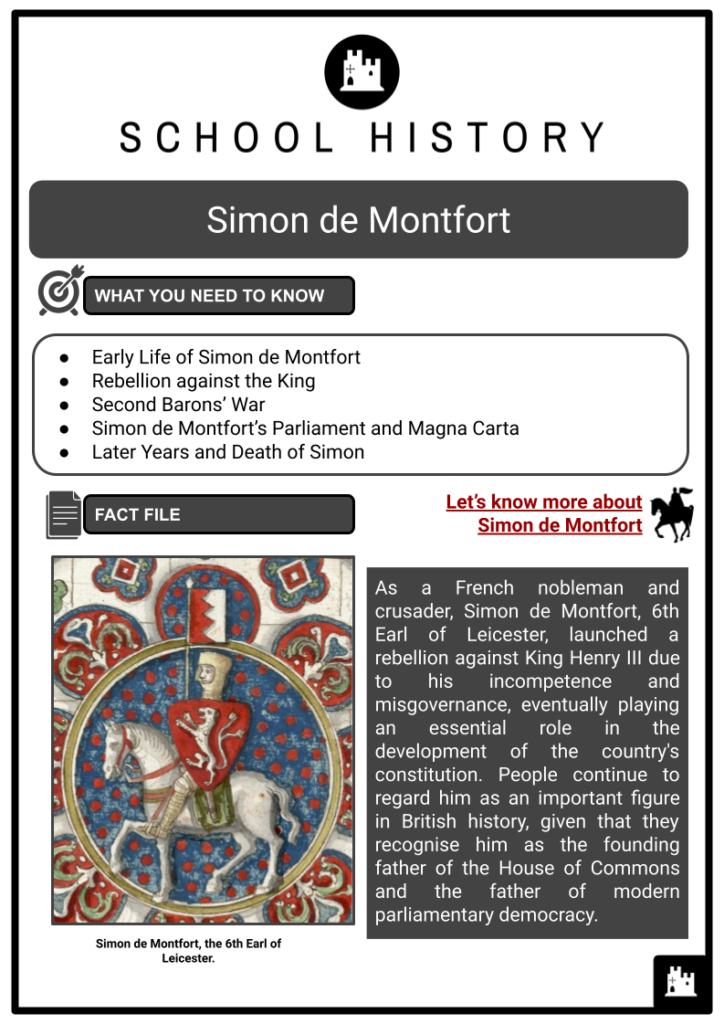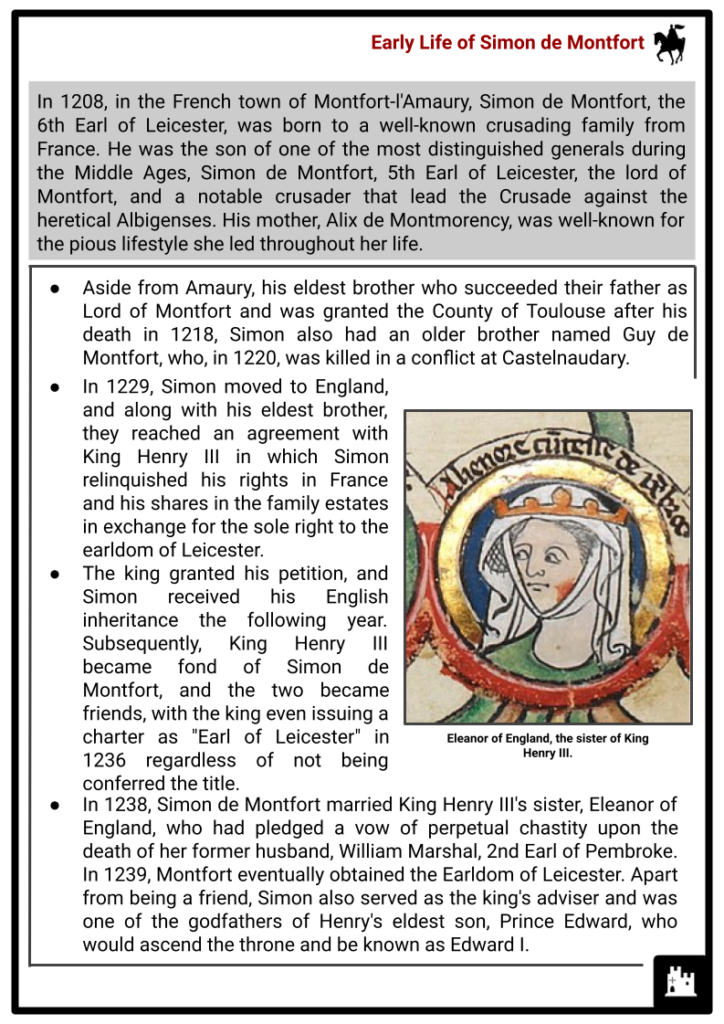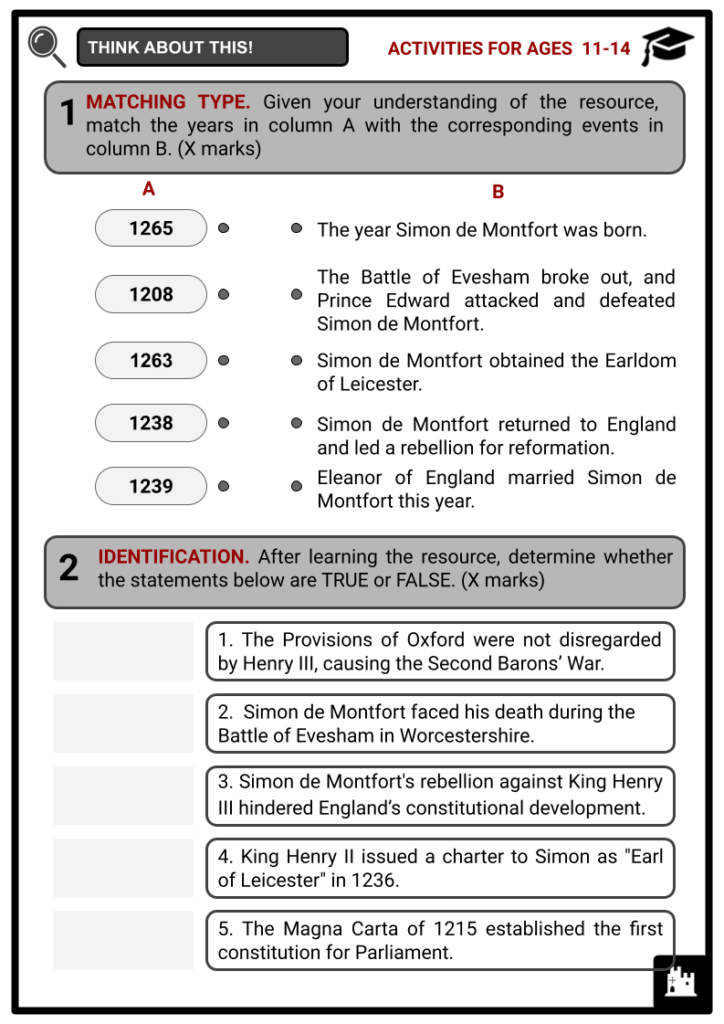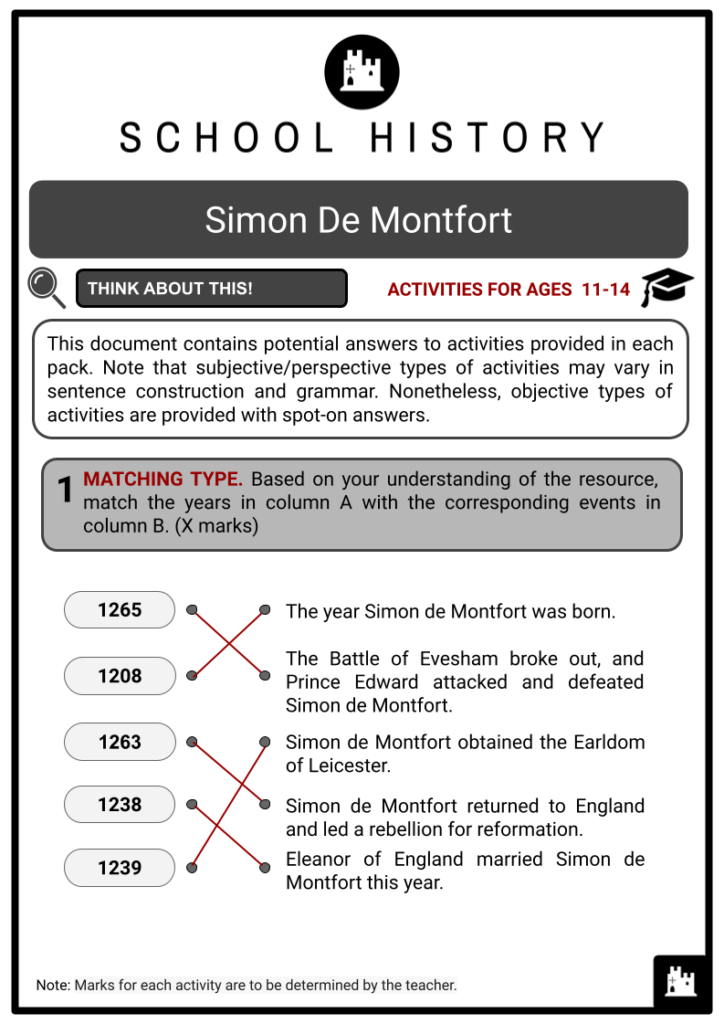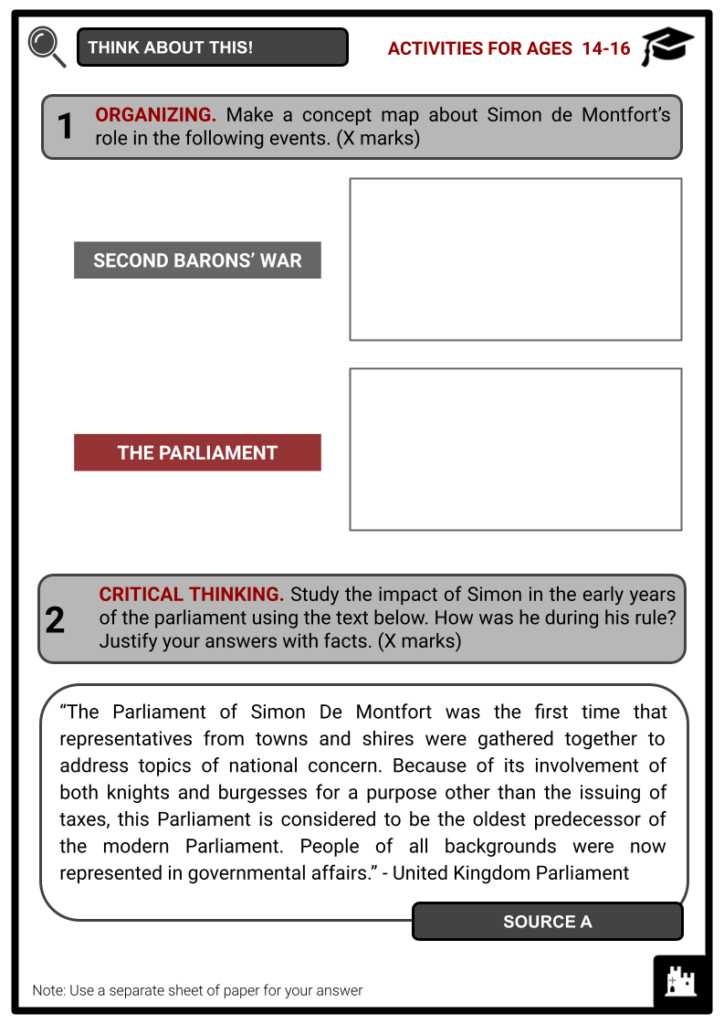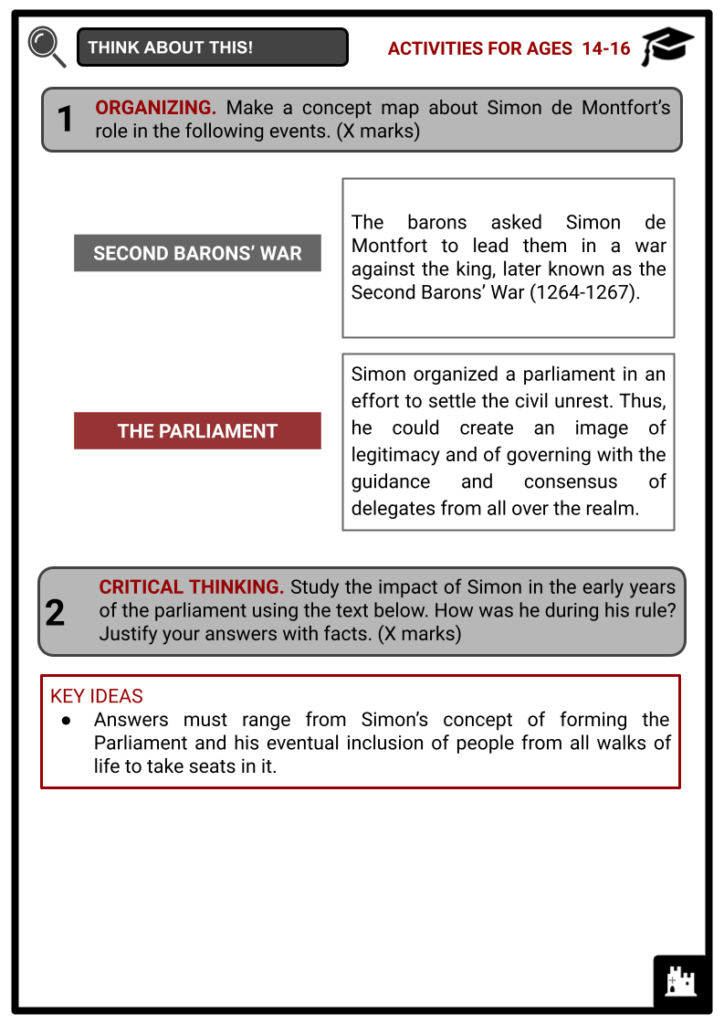Simon de Montfort Worksheets
Do you want to save dozens of hours in time? Get your evenings and weekends back? Be able to teach about Simon de Montfort to your students?
Our worksheet bundle includes a fact file and printable worksheets and student activities. Perfect for both the classroom and homeschooling!
Summary
- Early Life of Simon de Montfort
- Rebellion against the King
- Second Barons’ War
- Simon de Montfort’s Parliament and Magna Carta
- Later Years and Death of Simon
Key Facts And Information
Let’s find out more about Simon de Montfort!
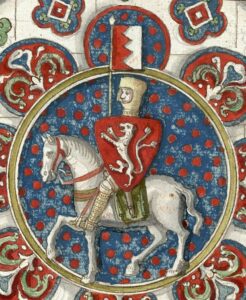
As a French nobleman and crusader, Simon de Montfort, 6th Earl of Leicester, launched a rebellion against King Henry III due to his incompetence and misgovernance, eventually playing an essential role in the development of the country's constitution. People continue to regard him as an important figure in British history, given that they recognise him as the founding father of the House of Commons and the father of modern parliamentary democracy.
Early Life of Simon de Montfort
- In 1208, in the French town of Montfort-l'Amaury, Simon de Montfort, the 6th Earl of Leicester, was born to a well-known crusading family from France. He was the son of one of the most distinguished generals during the Middle Ages, Simon de Montfort, 5th Earl of Leicester, the lord of Montfort, and a notable crusader that lead the Crusade against the heretical Albigenses. His mother, Alix de Montmorency, was well-known for the pious lifestyle she led throughout her life.
- Aside from Amaury, his eldest brother who succeeded their father as Lord of Montfort and was granted the County of Toulouse after his death in 1218, Simon also had an older brother named Guy de Montfort, who, in 1220, was killed in a conflict at Castelnaudary.
- In 1229, Simon moved to England, and along with his eldest brother, they reached an agreement with King Henry III in which Simon relinquished his rights in France and his shares in the family estates in exchange for the sole right to the earldom of Leicester.
- The king granted his petition, and Simon received his English inheritance the following year. Subsequently, King Henry III became fond of Simon de Montfort, and the two became friends, with the king even issuing a charter as "Earl of Leicester" in 1236 regardless of not being conferred the title.
- In 1238, Simon de Montfort married King Henry III's sister, Eleanor of England, who had pledged a vow of perpetual chastity upon the death of her former husband, William Marshal, 2nd Earl of Pembroke. In 1239, Montfort eventually obtained the Earldom of Leicester. Apart from being a friend, Simon also served as the king's adviser and was one of the godfathers of Henry's eldest son, Prince Edward, who would ascend the throne and be known as Edward I.
Rebellion against the King
- Simon and the king had a good relationship, yet they fell out when Simon owed a large sum of money to Queen Eleanor's uncle and used Henry III's name as security for reimbursement. He had not approved of this; thus, he furiously threatened to imprison Simon in the Tower of London.
- His feud with the king worsened when he realised what a poor leader he was after the latter ignored the country's growing discontent caused by a combination of factors such as the famine. The English Barons also noticed that the king was overly eager to favour his Poitevin and Savoyard relatives, which added to their tensions.
- With the intent of following Louis IX of France to Egypt, de Montfort took up the cross once more in 1248. However, because Henry III and the Council held high regard for Montfort's military abilities, the former dispatched him in the same year to govern and take control of the Duchy of Gascony, one of the last territories in southwestern France still under English control.
- Despite his dissatisfaction with the king’s incompetence and maladministration, Simon joined King Henry's various campaigns for a couple of years before deciding to reconcile with the king in 1253 in obedience to the dying Grosseteste, Bishop of Lincoln. But after failing to adhere to two parliaments, Simon De Montfort fled the country in despair in 1261.
- Driven by the king's hostility to all reform, the barons invited Simon de Montfort to return to England in 1263. Subsequently, a rebellion ensued with the purpose of transforming the government.
- For a time, this worked, but Prince Edward used bribes to turn some of the barons against de Montfort. The following year, 1264, civil war erupted.
The Second Barons’ War
- Henry refused to accept the Oxford Provisions and continued to rule in the same inept manner as before. The barons asked Simon de Montfort to lead them in a war against the king, later known as the Second Barons’ War (1264-1267).
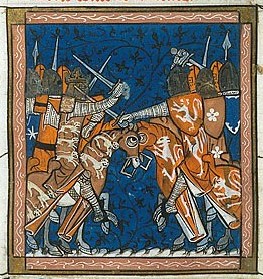
Second Barons’ War in England, the Barons (led by Montfort) on the right vs. Royals (led by Henry III) on the left. - There were four primary reasons that led to the Second Barons' War:
- Henry III ignored the Provisions of Oxford, and in 1261, he formally rejected such a provision.
- Henry III had been defeated in two major French wars.
- To make ends meet and pay the pope, Henry III raised taxes.
- Since many of his advisers were of French descent, the barons felt he had strong connection with them.
- There were two important battles during the Second Barons’ War:
- The Battle of Lewes in 1264, wherein the monarch and his son, Prince Edward, were seized. It was the first of two crucial battles that took place in 1264. It was the height of Simon de Montfort's career, making him the "uncrowned King of England”. He also convened England's first parliament, whereas Henry III left the security of Lewes Castle to fight the barons, with only partial success. Prince Edward led a successful cavalry charge that dispersed the London foot militia, but his knights failed utterly to rally and rejoin the fray. Thus, Montfortians overpowered the rest of the royalist army and seized the king.
- In the Battle of Evesham in 1265, wherein Prince Edward attacked and defeated Simon de Montfort, including the barons. King Henry III was successful in triumphing in the Second Barons' War. After the death of de Montfort, Henry's barons struggled, with many of them favouring the king.
Simon de Montfort’s Parliament and Magna Carta
- Simon de Montfort had two parliaments, one of which was the modern concept of a democratic representative parliament. Along with this emerged the House of Commons and Lords. The Magna Carta also played a significant role in placing limits on the ruling authority of a single man above the law.
- During his reign, Simon de Montfort had two parliaments. The second took place between January and March 1265 in Westminster, and it was from this that the modern concept of a democratic representative parliament was born.
- There were 23 lay magnates, 120 bishops, two knights from each county, and two citizens from each town who were summoned. In addition, there were four men brought in from each of the Cinque Ports. The Parliament was also called into session to deliberate on the plans for Prince Edward's release.
- All those who owned freehold land and paid an annual rent of 40 shillings were granted the right to vote in Parliamentary elections for county seats ("Forty-shilling Freeholders"). Most commoners were elected to parliament for the first time, creating the House of Commons' predecessor. The House of Lords was also formed by the barons and bishops, who were, by right, members of parliament.
- Montfort's Parliament laid the groundwork for a more representative democracy, just like the House of Commons today.
- Montfort’s Parliament links to the original Magna Carta of 1215. The Magna Carta represented lawful governance in the eyes of the knights and townsfolk whose support Montfort sought. It also declared that the council should be governed in line with the Charter's principles as the ruling authority under the law.
Did You Know?
- The Magna Carta of 1215 served two purposes. First, it maintained that taxation required the common agreement of a realm, which effectively meant the approval of Parliament. Second, the charter of 1215 established the first constitution for Parliament. In a sense, we see both the House of Lords and the House of Commons in that constitution. On one hand, the charter stated that the "great men of the realm are to be individually summoned to Parliament", which is the House of Lords.
Later Years and Death of Simon
- After the death of members of his army in a night attack in Kenilworth, Simon de Montfort met his end during the battle of Evesham. Following this was the overturning of the Provision of Oxford, restoration of the royal prerogatives, and reconfirmation of Henry III's version of the Magna Carta.

13th-century cloth illustration of Montfort's mutilation following the Battle of Evesham. - In August 1265, De Montfort and his army were awaiting the arrival of his second son's army. When he saw his son's banners soaring, he started to hope that between their two armies, they would have a chance to win the battle for England. His son, however, had been taken prisoner, and Prince Edward led the army while carrying de Montfort's stolen flags. De Montfort and his troops led the final assault from inside Evesham Church on their way to their deaths. The royal forces utterly decimated Simon's army, further mutilating his body at the Battle of Evesham, also referred to as the "murder of Evesham”.
- The conflict continued even after Simon de Montfort passed away. In 1266, an attempt was made to mediate peace through the Dictum of Kenilworth. This resulted in an overturn of the Provisions of Oxford, the re-establishment of the royal prerogative, and the reconfirmation by Henry III of the Magna Carta.
- During the summer of 1267, the remaining barons surrendered, bringing the war to an end. Even though Henry III and the papacy told people not to worship Simon de Montfort or talk about his miracles in public, this illegal but popular cult kept growing.

